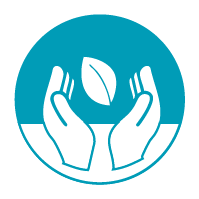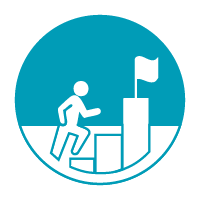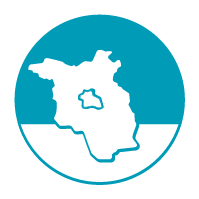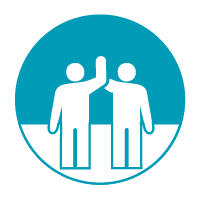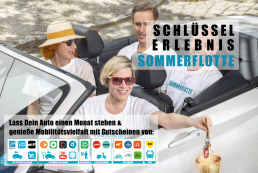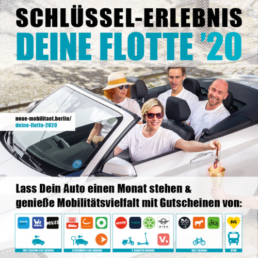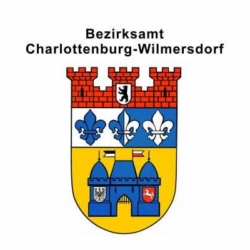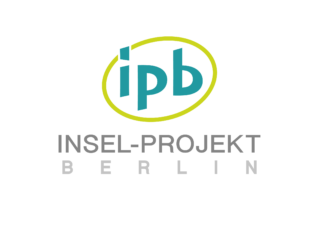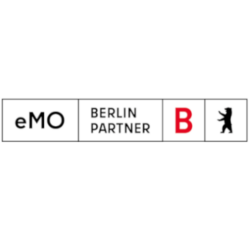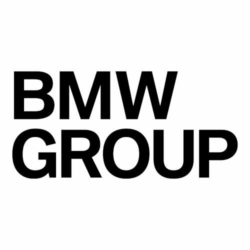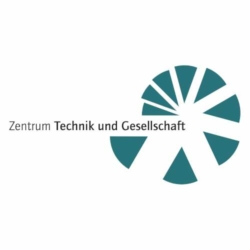NEW MOBILITY BERLIN
Freeing Up Spaces, Making Transformation Tangible
In a bustling city like Berlin, everyday mobility can often be easily managed by using buses, subways, car-sharing services, rental bikes, e-scooters and the like. Owning a private car is not essential for a large part of the population. Nevertheless, public space remains largely occupied by ‘stationary traffic’, that is, parked cars, many of which occupy scarce and valuable street space as they sit unused for days or even weeks.
For nearly a decade, the NEW MOBILITY BERLIN (NMB) project has been addressing this urban challenge by supporting car owners who are ready to reconsider their need for a private vehicle and explore a diverse range of mobility options.
NMB’s Guiding Principle: Every car that is removed from the city creates space for improving the quality of life for people and the environment in urban neighbourhoods and makes parking easier for those who depend on cars.
Implementation
In 2016, NEW MOBILITY BERLIN was launched on the Mierendorff-ISLAND in Berlin’s northwest and in the neighbourhood around Klausenerplatz. A survey of over 300 car owners provided valuable insights into daily mobility habits. This knowledge was crucial in shaping collaborative efforts to create more free spaces in the neighbourhood and redesign street spaces to be more people-centric. »»
Locations
From traffic-calmed zones and shared play areas to delivery spaces and urban gardening projects – our streets can be much more than just thoroughfares and parking spaces. Berlin’s first parklet was installed on two parking spaces in front of the office of project partner INSEL-PROJEKT BERLIN (IPB). The first dedicated parking spaces for car sharing were implemented in the heart of the neighbourhood. »»
People
Many Berliners don’t own a car. Of those who do, one-third rarely drive and don’t particularly enjoy the experience. We call them the ‘Car Independent Pragmatics’. They rely on cycling or public transport for their everyday mobility needs and are potentially open to giving up car ownership entirely. For the rare occasions that they’d need a car, there are now plenty of shared alternatives available. »»
MISSION: DIVERSE MOBILITY & QUALITY OF LIFE IN THE NEIGHBOURHOOD
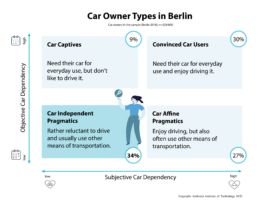
GATHERING & UNDERSTANDING
The ‘Travel Skeleton’ survey tool, developed by the Karlsruhe Institute of Technology on behalf of the BMW Group, was instrumental in supporting the NEW MOBILITY BERLIN project. It helped not only in capturing the everyday mobility behaviour of local residents — whether for work, shopping, or leisure — but also in examining occasional mobility, such as weekend trips, which often play a decisive role in car ownership within cities.
Psychological factors, such as attitudes toward different modes of transport, provided deeper insights into individual mobility patterns and car ownership than was previously possible.
Key Finding: The group of ‘Car Independent Pragmatics’ makes up more than one-third of the surveyed car owners. They rely on cycling or public transport for their daily journeys and are therefore potentially highly receptive to the idea of giving up private car ownership altogether. On the rare occasion that a car is needed, there are now numerous practical alternatives available. This target group represents significant potentials in creating relief effects on public space and new opportunities for urban development — not just in the pilot neighbourhoods, but across all of Berlin!

Copyright: NEW MOBILITY BERLIN / BMW GROUP
TRANSFERRING & IMPLEMENTING
Those who give up their cars can play a key role in driving the mobility transition. This is why we have introduced initiatives to make it easier for car owners to transition away from private vehicle ownership toward the array of novel multimodal options. In focus groups, we collaborated with local residents to develop alternative uses for streets. These concepts were implemented in 2016 and 2017 through action weeks and days promoting diverse multimodal mobility, as well as parklets and additional seating areas on streets.
Cultural events, such as public book readings and singer-songwriter performances, brought a comforting and inspiring sense of normality to spending time on asphalt spaces traditionally
reserved for parked cars. The anticipated conflicts with car owners, who perceive public spaces solely as parking areas, were constructively addressed through several participatory events. Over time, many of those who initially criticised the NMB project came to understand that they too could benefit from reduced parking pressure.
The most significant contribution to this transformation was the five-year campaign ‘YOUR FLEET”.
INITIATIVES WITHIN THE NMB PROJECT
The participatory campaign ‘YOUR FLEET’ offered car owners the opportunity to explore how their everyday lives could work without a private car and which alternative mobility options suited them best. During this time, participants managed their mobility for a month using an extensive range of vouchers and free minutes provided by Berlin’s sharing mobility companies. Participants were guaranteed unique and meaningful experiences
2018
For the first time, residents of the Mierendorff-ISLAND and Klausenerplatz neighbourhoods were able to test their everday mobility routines without their own cars for a month. This was made possible with vouchers from 11 mobility providers, including car-, ride-, scooter-, and bike-sharing services, as well as public transport. »»
2019
More than 50 car owners from Berlin’s Charlottenburg-Wilmersdorf district participated in a mobility month, using vouchers from 20 sharing mobility providers. Before and after the campaign, we surveyed participants to better understand their mobility habits and to assess the usability of multimodal mobility options within the district. »»
2020
With support from the public broadcasting station Rundfunk Berlin-Brandenburg (rbb), we expanded the ‘YOUR FLEET’ campaign from Berlin to Brandenburg. Even in regions with limited sharing mobility options, car owners from Berlin’s surrounding areas and Potsdam were able to participate in the initiative successfully. »»
2021/2022
Supported by funding from the Berlin Energy and Climate Protection Programme (BEK), ‘YOUR FLEET’ returned to its origins. Despite the challenges of the pandemic, 30 participants joined the campaign to assess their own mobility behaviour, with numerous opting to switch from a car-oriented mobility lifestyle to one that embraced multimodal options. »»
WHAT WE’VE LEARNED SO FAR – A PROGRESS REPORT
Many car owners from the ‘Car Independent Pragmatics’ group hold on to their private vehicles to ensure they can handle occasional needs beyond everyday mobility. However, experiences like ‘YOUR FLEET’ illustrate that family visits, leisure trips to Berlin’s surrounding areas, and even holidays can be managed conveniently with car sharing or similar options.
The freed parking spaces which become available when car owners switch to alternative mobility options play a vital role in the much-needed redesign of neighbourhoods. The noticeable decline in car ownership per household in Berlin now gives local authorities a strong basis to promote more diverse and people-centric uses of public street space.
A striking outcome of our surveys in the NMB project was however that before focusing on improving the quality of street life, many people consider enhancing traffic safety in their neighbourhoods to be a more pressing concern. The district of Charlottenburg-Wilmersdorf is addressing this need by implementing traffic-calming measures in many neighbourhoods, ensuring safer conditions for all population groups to navigate the streets.
This approach illustrates that there are ample opportunities to reduce conflicts over street space, while also improving the sustainability and efficiency of mobility patterns and enhancing the quality of life for all residents.
THE PARTNERS – A STRONG ALLIANCE FOR CHANGE
NMB sees itself as an open platform and a catalyst for changemakers who are passionate about driving mobility transitions. To realise the project’s vision together with interested local and regional partners, a transdisciplinary consortium has been formed, bringing together municipalities, businesses, economic development organisations, and the scientific community.
-1-uai-215x258.png)
-1-uai-215x258.png)
-1-uai-215x258.png)
FOLLOW-UP PROJECTS, IMPACTS & NETWORKS
Since 2016, the NEW MOBILITY BERLIN team has been actively working to promote diverse mobility options and improve the quality of life in the city. Over time, the idea of neighbourhoods with more space for alternative street uses has spread, inspiring other urban pioneers with similar goals.
Among these are projects in Munich, such as ‘Umparken Schwabing‘ and ‘Bestandsquartier der Zukunft‘, both of which were directly inspired by NEW MOBILITY BERLIN.
The ‘Travel Skeleton’ developed as part of the NEW MOBILITY BERLIN project has also been adopted in many other cities. An overview of the studies and numerous publications can be found here: https://mobilitaetsskelett.ifv.kit.edu/index.php .
In Germany and worldwide, projects are initiated through independent efforts and in close collaboration with cities, inspiring other municipalities, communities and projects along the way. If you feel inspired by NMB, we would be happy to support you in the planning or implementation of your own project!
We’d be delighted to include your project on our map as well! Just write us a message at mail@insel-projekt.berlin
